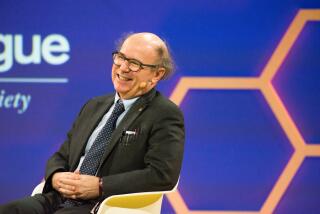The Heavenly Union of Inner and Outer Space
- Share via
Science has a long history of making strange bedfellows.
The steady, stately orbits of heavenly bodies are intimately connected with the unpredictable plop of falling apples from a tree. Electric sparks are tied to magnetic attraction. Waves are the flip side of particles.
No one understood this better than Albert Einstein, who showed that time is entangled with space, gravity is in the grip of geometry and matter is a “frozen” form of energy.
Einstein would no doubt have been delighted with NASA chief Dan Goldin’s recent efforts to bring about a marriage between the physics of subatomic particles and the physics of outer space.
Not that physicists needed Goldin to tell them that there was something going on between these two. After all, one of the biggest mysteries in physics is the fundamental nature of the matter that makes up the universe. Yet it was astronomers--not physicists--who first discovered that at least 90% of that matter is of some unseen, perhaps exotic, variety.
So physicists have known for years that one way to make discoveries about fundamental particles is by looking through the portal of space.
Now Goldin--ever the yenta--is pushing to make the marriage official. Two years ago, he showed up at the nation’s foremost particle lab--Fermilab outside Chicago--to goad the particle physicists to consider using space as their laboratory. And when Goldin goads, people tend to respond.
In this case, a diverse group of physicists and astronomers (humbly calling themselves the Committee on the Physics of the Universe) responded with a report, “Connecting Quarks With the Cosmos,” intended to be the first step toward Goldin’s goal.
“You cannot separate inner space from outer space,” said the University of Chicago’s Michael Turner recently at an astronomy meeting in San Diego, formally presenting the committee’s findings. “Some of the most profound discoveries have come right at the boundary of the two.”
Many more, he thinks, are just around the corner. “These are areas where we’re poised to make progress, if we just give a little push,” he said.
For example, many large-scale mysteries are going to have to be explained by elementary processes. Why is the universe made of matter, when matter and antimatter always come into being in exactly equal amounts? Where did all the antimatter go? The answer will come from examining the details of how particles interact.
Or, why do at least a third of tiny particles called neutrinos seem to disappear on their journey from the sun to the Earth? Are they shifting into different, undetectable forms en route? Do neutrinos constitute a significant part of the dark matter that makes up the majority of the matter in the universe?
Or, what force caused the universe to expand exponentially in its early years, and is that same repulsive force (or something like it) causing the expansion to accelerate again today? The answer may lie in a detailed understanding of the vacuum of empty space.
*
This merger mania between large and small pervades physics. The most energetic particles in the universe are cosmic rays streaming from outer space--and they are probably produced in some kind of colossal outburst involving massive stars. A new state of matter (sometimes called “quark matter”) is being sought in earthbound accelerators; but super-dense stars might already be making the stuff naturally. The most massive objects in the universe--black holes--also contain the singular points in space-time where the known laws of nature may well begin to break down.
In fact, the largest structures in the universe--the million-light-year-long strings of galaxies that drape the sky like garlands--probably started out as subatomic-scale wiggles in the very early universe.
So forget AOL-Time Warner. Think particles and space--a marriage truly made in heaven.
As Goldin told the astronomers in San Diego last month: “Buckle up your seat belts, folks! It’s time to think about some of the wonderful things we could do with this natural laboratory! . . . Perhaps one day soon, some adventurous souls will win Nobel Prizes for breakthroughs in fundamental physics using space-based observations!”
*
Cole can be reached at kc.cole@latimes.com.






